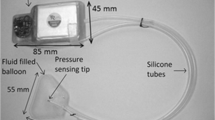Abstract
Introduction and hypothesis
Walking speed and carrying technique affect intra-abdominal pressure (IAP) in women. In this study, we tested the feasibility of monitoring IAP outside the laboratory environment and compared IAP while study participants were (1) carrying 13.6 kg (similar to a 3-month old in car seat) in six different ways while walking 100 m; and (2) while walking 400 m at self-selected slow, normal, and fast paces.
Methods
Forty-six healthy women between 19 and 54 years completed the walking and lifting activities; the order for each was randomized. IAP was monitored with an intravaginal pressure transducer that wirelessly transmitted pressure data to a portable base station. We analyzed maximal peak IAP and area under the curve (AUC) IAP.
Results
Monitoring IAP outside of the laboratory was feasible. Mean maximal IAP during walking increased as pace increased: 42.5 [standard deviation (SD) 10.2], 50.5 (10.9), and 62.0 (12.1) cmH2O for slow, medium, and fast speeds, respectively: p < 0.0001 by mixed-model analysis of variance (ANOVA). The corresponding AUC of IAP for walking decreased as pace increased. The awkward carry, side carry, and front carry activities each resulted in higher mean maximal IAP [65.8 (10.6), 67.7 (12.8), and 77.3 (13.1) cmH2O, respectively] than the carry-in-backpack activity [55.5 (11.4) cmH2O; p < 0.0001].
Conclusion
Subtle variations in walking speed or method of carrying a toddler-size load can produce significant changes in IAP. Whether these changes increase the risk of pelvic floor disorders is not yet clear. However, these data suggest that further inquiry into optimal methods and appliances to assist women in carrying may create a lower IAP profile.



Similar content being viewed by others
References
Nygaard I, Barber MD, Burgio KL et al (2008) Prevalence of symptomatic pelvic floor disorders in US women. JAMA J Am Med Assoc 300:1311–1316
Hendrix S (2002) Pelvic organ prolapse in the women’s health initiative: gravity and gravidity. Am J Obstet Gynecol 186:1160–1166. doi:10.1067/mob.2002.123819
Moalli PA, Ivy SJ, Meyn LA, Zyczynski HM (2003) Risk factors associated with pelvic floor disorders in women undergoing surgical repair. Obstet Gynecol 101:869
DeLancey JOL, Kane Low L, Miller JM et al (2008) Graphic integration of causal factors of pelvic floor disorders: an integrated life span model. Am J Obstet Gynecol 199:610.e1–5. doi:10.1016/j.ajog.2008.04.001
Take the floor; voices for PFD. In: Voices for PFD (2008). http://www.voicesforpfd.org/p/cm/ld/fid=25. Accessed 9 Apr 2014
Coleman TJ, Thomsen JC, Maass SD, et al. (2011) Development of a wireless intra-vaginal transducer for monitoring intra-abdominal pressure in women. Biomed Microdevices 1–9
Johnson PJ, Rosenbluth EM, Nygaard IE et al (2009) Development of a novel intra-vaginal transducer with improved dynamic response. Biomed Microdevices 11:1213–1221
Hsu Y, Coleman TJ, Hitchcock RW et al (2012) Clinical evaluation of a wireless intra-vaginal pressure transducer. Int Urogynecol J 23:1741–1747
Shaw JM, Hamad NM, Coleman TJ et al (2014) Intra-abdominal pressures during activity in women using an intra-vaginal pressure transducer. J Sports Sci 32:1176–1185
Thomas S, Reading J, Shephard RJ (1992) Revision of the physical activity readiness questionnaire (PAR-Q). Can J Sport Sci
Craig CL, Marshall AL, Sjostrom M et al (2003) International physical activity questionnaire: 12-country reliability and validity. Med Sci Sports Exerc 35:1381–1395. doi:10.1249/01.MSS.0000078924.61453.FB
Hamad N, Shaw J, Nygaard I et al (2013) More complicated than it looks: the vagaries of calculating intra-abdominal pressure. J Strength Cond Res 27:3204–3215
Harrell FE (2001) Regression modeling strategies: with applications to linear models, logistic regression, and survival analysis. Springer, New York
Grillner S, Nilsson J, Thorstensson A (1978) Intra-abdominal pressure changes during natural movements in man. Acta Physiol Scand 103:275–283
McCarthy TA (1982) Validity of rectal pressure measurements as indication of intra-abdominal pressure changes during urodynamic evaluation. Urology 20:657–660
Fusco MA, Martin RS et al (2001) Estimation of intra-abdominal pressure by bladder pressure measurement: validity and methodology. J Trauma 50:297
Dolan LM, Dixon WE, Brown K et al (2005) Randomized comparison of vaginal and rectal measurement of intra-abdominal pressure during subtracted dual-channel cystometry. Urology 65:1059–1063
Iberti TJ, Kelly KM, Gentili DR et al (1987) A simple technique to accurately determine intra-abdominal pressure. Crit Care Med 15:1140
Lewis Wall L, Hewitt JK, Helms MJ (1995) Are vaginal and rectal pressures equivalent approximations of one another for the purpose of performing subtracted cystometry? Obstet Gynecol 85:488–493
Egger MJ, Hamad NM, Hitchcock RW, Coleman TJ, Shaw JM, Hsu Y, Nygaard IE. (2014) Reproducibility of intra-abdominal pressure measured during physical activities via a wireless vaginal transducer. In press, female pelvic medicine and reconstructive surgery
Acknowledgments
We thank Sarah Holdsworth, Harrison Padgen, Chis Chisholm, Casey Fenger, and Destanae Howerton-Davis for their assistance in conducting the exercise protocol. We also thank Johanna de Gennaro and Melissa Warren for their help with building sensors used in this study. The project described was supported by Grant Number R01HD061787-01 from the Eunice Kennedy Schriver National Institute of Child Health and Human Development. Its contents are solely the responsibility of the authors and do not necessarily represent the official views of the National Institutes of Health.
Conflict of interest
None.
Author information
Authors and Affiliations
Corresponding author
Rights and permissions
About this article
Cite this article
Coleman, T.J., Hamad, N.M., Shaw, J.M. et al. Effects of walking speeds and carrying techniques on intra-abdominal pressure in women. Int Urogynecol J 26, 967–974 (2015). https://doi.org/10.1007/s00192-014-2593-5
Received:
Accepted:
Published:
Issue Date:
DOI: https://doi.org/10.1007/s00192-014-2593-5




